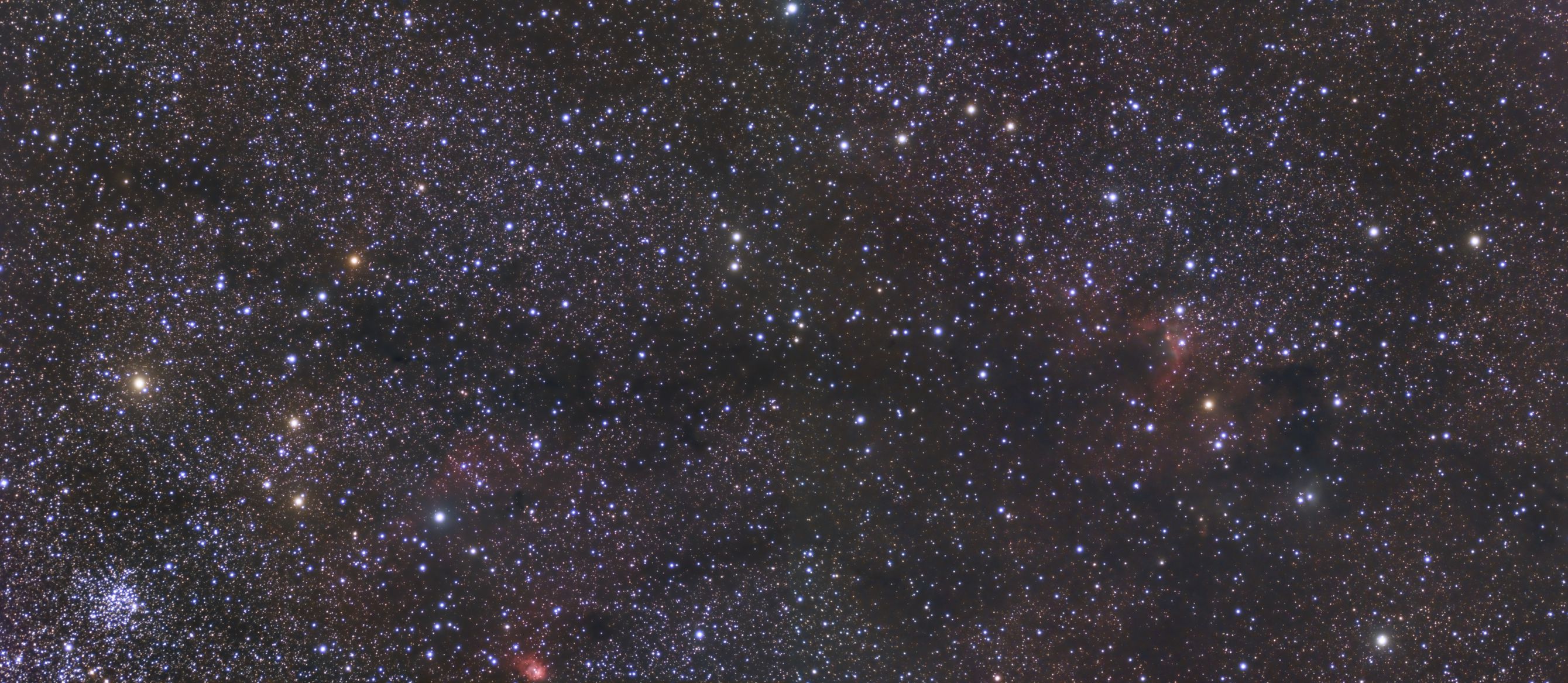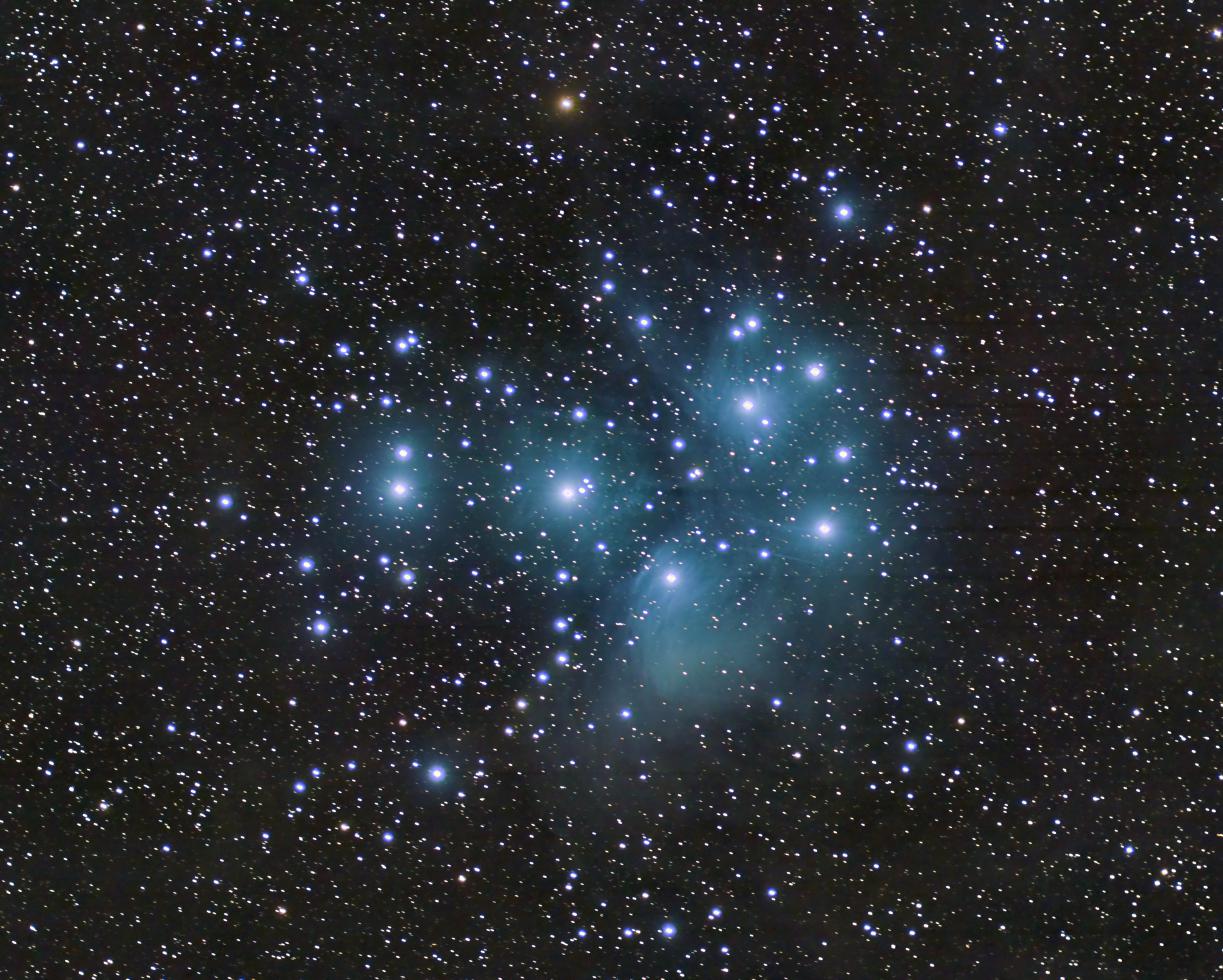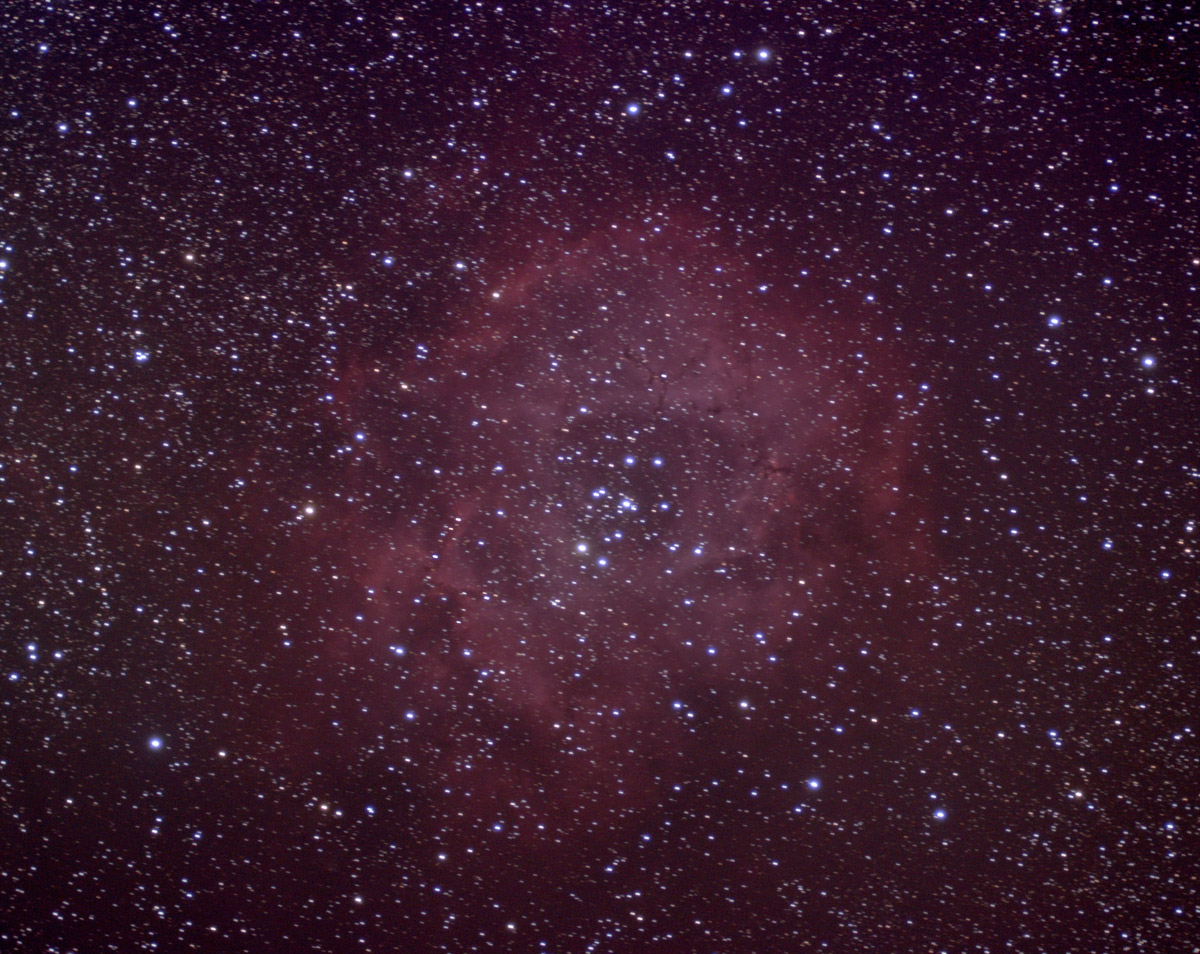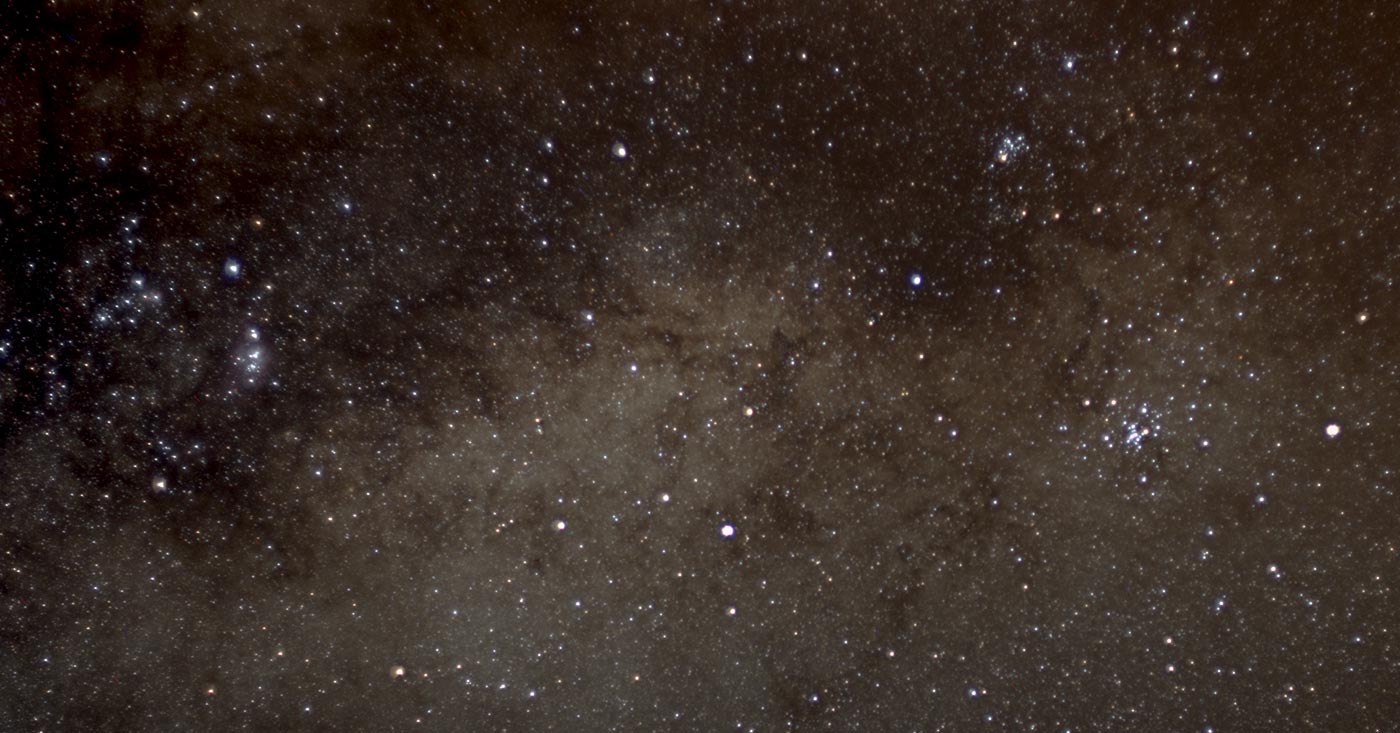This is a test image checking operation of my new imaging setup based upon the Takahashi FSQ85-ED ‘Baby-Q’. After running several V curves in FocusMax I took 12x 5 minute exposures of M45. This is a good test of the optics as the stars are very bright and are a useful check for spurious reflections.
I’ve built a new flat panel using a larger EL panel and some translucent polycarbonate. The panel is still a little bright and I’ll need add a little more attenuation to enable me to use somewhat longer exposures to eliminate shutter artifacts.

Category: Open Cluster
Sharpless 2-155 and M52
I’ve finally got around to combining the remaining data into a mosaic of this area. Using a different technique to merge the images in Pixinsight I’ve removed the visible join that was due to a light pollution gradient in the original.
Sh2-155 is a region of Ha emission overlaid with dust in our galaxy, some of it thick enough to block the more distant stars completely and appear black.
This is a total of 10 hours 20 minutes of 10 minute subframes.

Fireworks galaxy and NGC 6939
No complaints about the British weather this weekend. The clear nights at the Haw Wood star party were a treat. This weekend, with the moon waning, both Friday and Saturday night were forecast to be clear.
Friday night had some cloud drifting through from time to time. I was also trying to get to grips with CCD Commander before it’s trial license expired so I had some work to do. In the end, I gathered about 3 hours 40 minutes worth of 10 minute sub frames of this pretty pairing in Cepheus.
An initial look at the data looked promising. I did have a problem with the flat field frames though. These were taken at dawn by CCD Commander but I’d turned the coolers off beforehand. As a result, the flat wasn’t a good match for the light frames so I needed to redo these. I haven’t measured the bias levels at different temperatures but I suspect that it varies wildly.
On Saturday I setup early for dusk flats then waited for dark. During the day I’d taken the step of installing the new NoMachine remote control software, both on my Netbook and main PC. As the Netbook is Windows 7 Starter edition, I don’t have the option of running Remote Desktop Protocol (RDP). The new software has the advantage over the popular VNC of passing sound to the client PC. This should enable me to hear audible alerts from Maxim inside the house.
I collected a further 3 hours of data. taking me up to 6 hours 30 minutes. This is the longest I’ve ever exposed on a single target. The bright blue foreground stars create a severe challenge for the doublet Zenithstar which shows significant colour fringing.
Cepheus wide field
The original intention with this picture was to take 5 hours of sub frames of the Cave nebula (Caldwell 9), aka Sh2-155 in Cepheus. However, a problem with the focusser meant that after the first 90 minutes the remaining images were offset in RA. Fortunately, there was enough overlap to enable me to join the images in a wide field mosaic. The bright cluster bottom left is M52.
There’s some residual light pollution down the centre of the image. This is very hard to deal with in mosaics. Also, there’s a lot more noise in the right hand side due to the relative lack of exposures.
Haw Wood Farm star party
Breckland’s Haw Wood Farm star party has been and gone but what a weekend is was with very good conditions all week. I attended on the Friday and Saturday nights. Friday was clear until about 3:30am, Saturday, 2am.
On Friday evening I finished the evening at about 1am by setting up a sequence in CCD Commander (which I’m trialling at the moment) of 3 minute images of M45 and went to bed. Waking at 3am, I packed up the gear as it had clouded over and rain was forecast.
In all, I collected 45 exposures. Trailing continued to be a problem throughout the weekend but I have a theory that it’s due to some slight vibration from the camera fan. My thanks to John Hipperson for putting the idea in my head.
M39
While waiting for it to get dark last night (there is no astronomical twilight in the UK at this time of year) I took about thirty 30 second images of M39 in Cygnus. The sky background was still very light but during processing a planetary nebula appeared nearby. As I’ve mentioned before, my favourite tool for identifying this sort of object is Aladin and this showed it to be Minkowski 1-79 (1946).
Also in the field is the rather faint open cluster Platais 1. One of it’s member stars is the Cepheid variable V1726 Cyg with a period of 4.2 days and diminutive brightness range of 8.87 to 9.06.
There are two readily identified double stars in M39; h1657 with a separation of 21.6″ and A770, rather closer at 7″.
North is up.
After imaging comet Ison I moved on to a small galaxy in Gemini (picture to follow) and NGC 2264 in Monoceros. The 20″ seemed to be behaving itself, and, with a nice bright star in the cluster, guiding was straight forward. 20 thirty second exposures were acquired and most were good enough to stack. Stacking was performed in Maxim and the resultant floating point fits file was transferred into PixInsight for further processing.
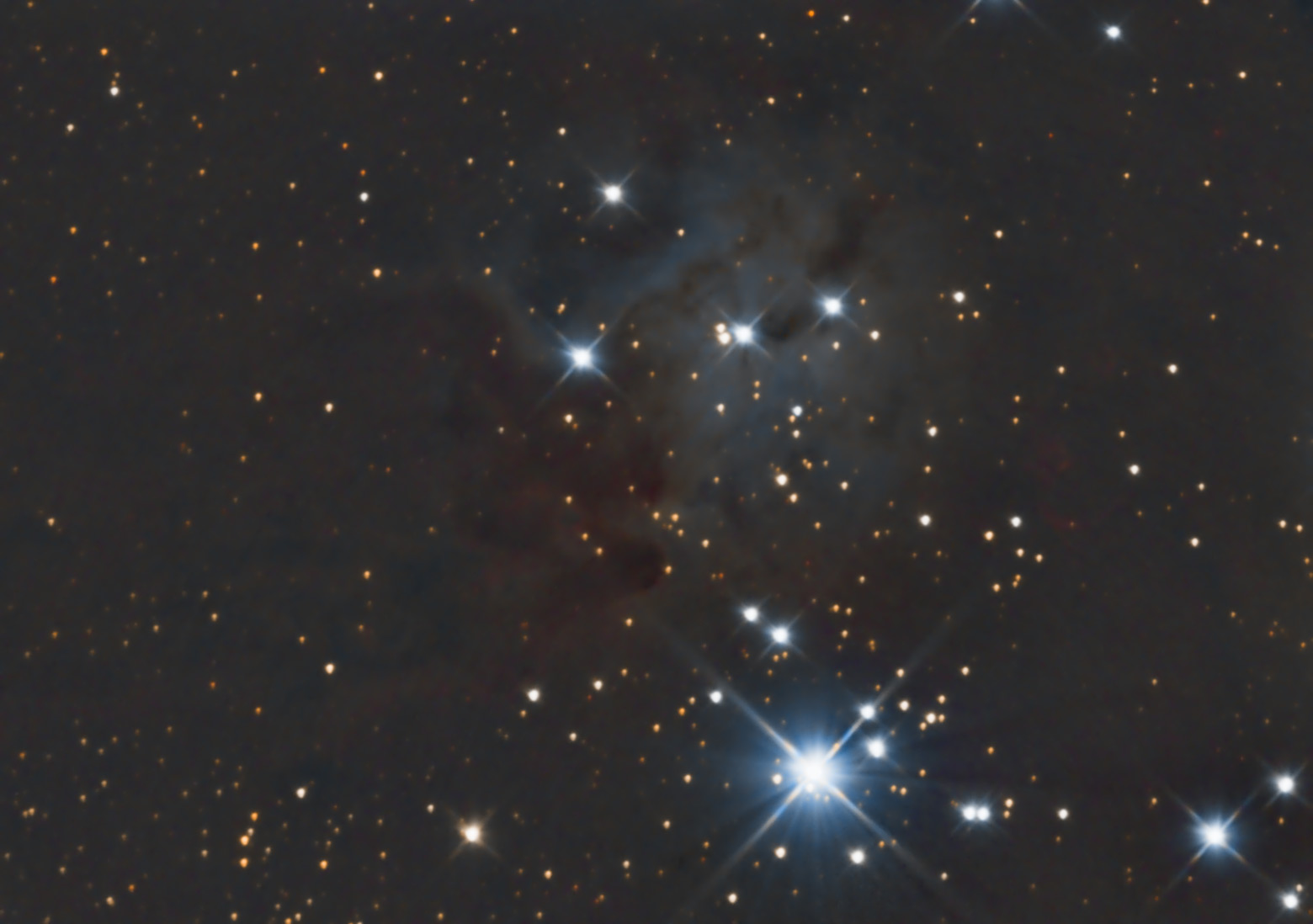 This image would benefit from longer exposures as the nebula is pretty faint. However, it’s one of the better 20″ pictures that I’ve produced.
This image would benefit from longer exposures as the nebula is pretty faint. However, it’s one of the better 20″ pictures that I’ve produced.
Treasures in Auriga
This week has been a surprise with clear nights and no moon, albeit rather hazy. Having missed sunday evening, monday evening took a while to clear and Auriga was getting rather low by the time I started imaging. However, before it dropped into the haze I got 30 minutes worth of the area around IC405 and IC410 using 3 minute exposures.
The next opportunity was on wednesday and with the skies clearing earlier in the evening I added another 90 minutes of exposures. It helps that the central cluster is so bright which makes centring the image easier.
One image had a satellite trail so here’s the result of stacking the remaining 44 frames.
 Telescope: WO Zenithstar 70 with FFIII
Telescope: WO Zenithstar 70 with FFIII
Camera: QHY9C
Mount: Astrotrac
The Rosette nebula
Monday evening was the clearest of the year so I put the Zenithstar on the Astrotrac with the QHY9C and pointed it towards the Rosette nebula. The central cluster was an easy binocular object and using the red-dot finder the telescope was pointed without difficulty.
While the polar alignment looked reasonably accurate there was some drift in RA that I will need to eliminate. Cable drag is one possibility I’ve looked at before but I suspect that the Astrotrac is tracking at the wrong rate and may require recalibration.
Trailing was quite pronounced on 5 minute exposures but I took 19 images of this length.
Scorpius Clusters
Reviewing one of the folders of images that I took in La Palma I came across this one that I’d stacked, mis-labelled and forgotton about. Once I started to look at it a little closer I realised that the stars were very misshapen with ones at the bottom of the frame appearing as small eclipsed disks. Vignettting was also very pronounced and uneven. Checking the focal length revealed it was taken with the Canon 18-55mm kit lens. I really must replace this lens at the first opportunity!
This is a severely cropped version of the image, showing the area from the clusters M6 & M7 at the right to nebulae M20 & M21 at the left.
10 90 second frames at ISO 800 with the Canon 350D.

